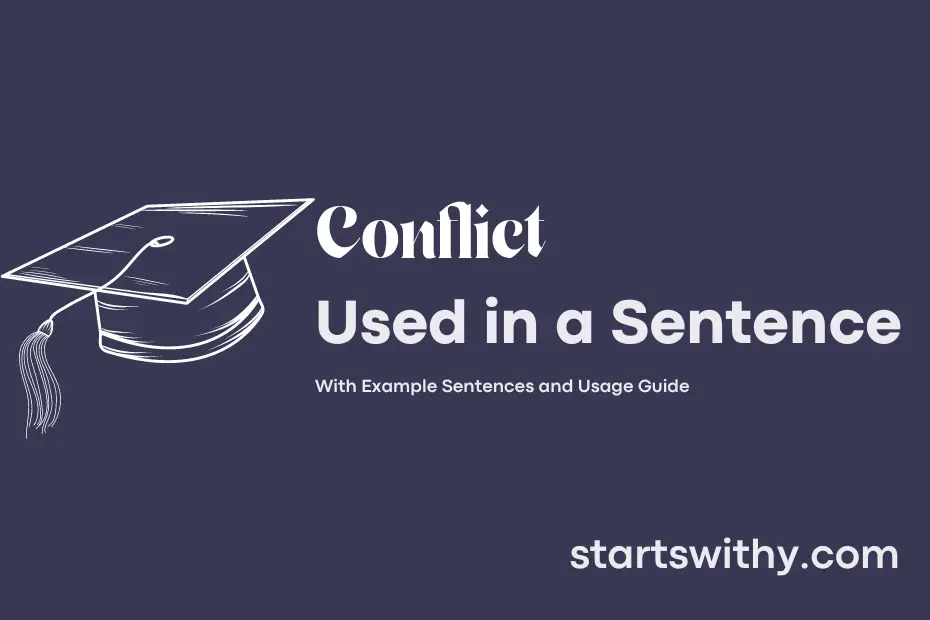Conflicts are disagreements or disputes that arise when individuals or groups have differing views, interests, or goals. This clash can happen in various settings, such as personal relationships, workplaces, or between nations, and may result in tension, frustration, or hostility.
Being able to navigate conflicts effectively is a valuable skill that can lead to improved communication, cooperation, and relationships. By understanding the root causes of conflicts and learning conflict resolution strategies, individuals can work towards mutual understanding and compromise, ultimately fostering a more peaceful and productive environment.
7 Examples Of Conflict Used In a Sentence For Kids
- We should talk nicely to resolve conflict.
- Sharing toys can help avoid conflict with friends.
- We can ask a teacher for help if there is a conflict.
- It’s important to listen to each other during a conflict.
- Apologizing can help solve a conflict quickly.
- Taking turns is a good way to prevent conflict.
- Sometimes taking deep breaths can calm a conflict.
14 Sentences with Conflict Examples
- It is common for students to face conflict between spending time studying or socializing with friends.
–Conflict often arises when group members have differing opinions on how to approach a project. - Balancing part-time work with academics can lead to conflict in a student’s schedule.
- Conflict can occur between roommates over issues such as cleanliness or noise levels.
- Conflict may arise between students and faculty over academic policies or grades.
- Joining multiple clubs and organizations on campus can sometimes lead to conflict in a student’s schedule.
- Conflict can arise when students have different ideas on how to allocate funds for an event or project.
- A lack of communication can lead to conflict within group projects among college students.
- Feeling torn between pursuing a passion and choosing a more practical career path can cause conflict for students.
- Conflict can arise when friends have differing opinions on important issues such as politics or religion.
- Not being able to attend both a friend’s birthday party and a study group session can lead to conflict for students.
- Having to choose between attending a family function and a college event can create conflict for students.
- Conflict may arise between student groups when planning an event that caters to different interests.
- Struggling to maintain a work-life balance can lead to conflict for college students.
How To Use Conflict in Sentences?
Conflict can be used in a sentence as a noun to describe a disagreement or argument between two or more people, groups, or ideas. When using “conflict,” it is important to understand how to structure a sentence effectively. Here is a guide for beginners on how to use the word “conflict” in a sentence:
-
Subject-Verb-Object Structure: When using “conflict” in a sentence, start with a subject (who or what the sentence is about), followed by a verb (the action), and end with an object (the thing that is affected by the action). For example, “The two friends had a conflict over which movie to watch.”
-
Descriptive Sentences: You can use “conflict” to describe a situation in more detail. For instance, “There was a conflict between the students about where to go for lunch.”
-
Appealing to Emotions: You can convey emotions in a sentence using the word “conflict.” For example, “The family’s conflict brought tears to everyone’s eyes.”
-
Connecting Ideas: Use “conflict” to show a contrast or contradiction in a sentence. For instance, “The conflict between his words and actions was confusing.”
By following these guidelines, beginners can effectively incorporate the word “conflict” in a sentence to convey disputes, disagreements, or struggles. Practice using “conflict” in different contexts to improve your sentence structure and communication skills.
Conclusion
In conclusion, sentences that include conflict can often reveal tension, disagreement, or struggle between individuals, groups, or ideas. These sentences can convey a variety of emotions and complexities, adding depth and drama to written or spoken communication. Whether showcasing a character’s internal turmoil, political disagreements, or personal arguments, conflict-laden sentences help to drive narratives forward and engage readers or listeners. By highlighting differences, challenges, or obstacles, conflict in sentences can create suspense, evoke empathy, and catalyze change within stories or discussions.
Understanding the power of conflict in sentences can be key to effective storytelling, persuasive writing, or fruitful debates. By acknowledging and navigating conflicting perspectives or interests, individuals can foster understanding, negotiate solutions, and ultimately promote growth and resolution. Embracing conflict in sentences as a natural part of communication can lead to richer, more engaging interactions that spark critical thinking, creativity, and meaningful connections.



